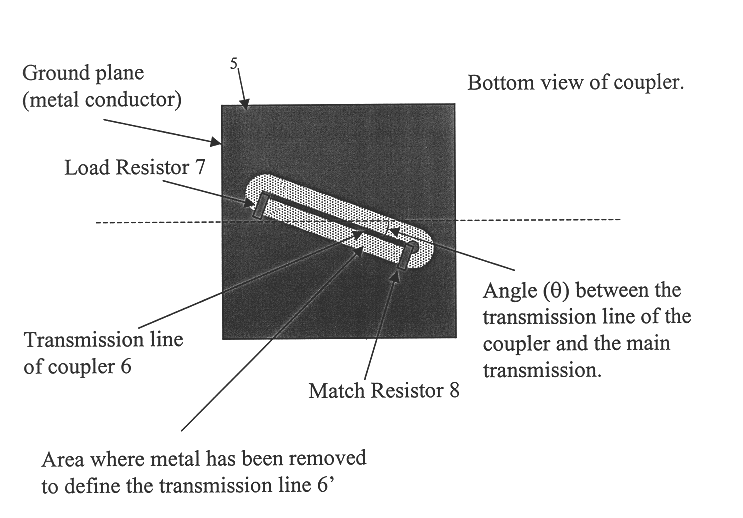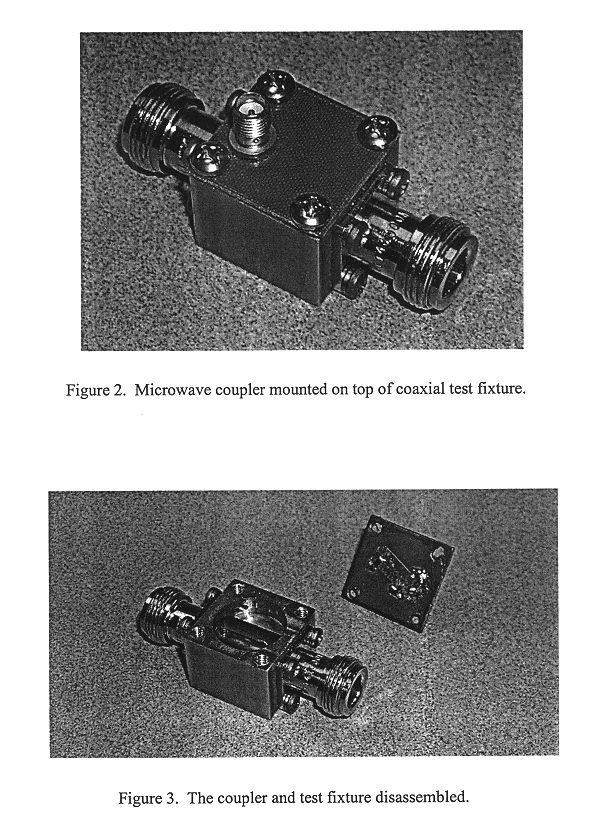Coplanar directional coupler for hybrid geometry
a technology of coplanar directional coupler and hybrid geometry, which is applied in the direction of multiple-port network, electrical apparatus, waveguide, etc., can solve the problems of over-tuned process, variable coupling factor, and coupler taking up to fifteen minutes to tune correctly
- Summary
- Abstract
- Description
- Claims
- Application Information
AI Technical Summary
Benefits of technology
Problems solved by technology
Method used
Image
Examples
first embodiment
FIG. 1(a) illustrates a planar coupler 1 according to the invention, assembled with a housing 2 and a main transmission line 3. A connector 4 connects the coupler with a measurement device or other RF sub-system. The coupler includes a printed circuit board, with a conductor provided on the plane facing the transmission line 3, and a dielectric on the other plane of the board substrate. Copper may be used as a standard conductor material, but other conducting materials may be used. The housing 2 is designed with a distance D between the transmission line 3 and the bottom face of the coupler to provide a specified coupling factor.
Referring to FIG. 1(b), the microwave coupler includes a planar circuit 5 on which a coupling transmission line 6 has been described. The transmission line 6 merely comprises a part of the conductive plate, from which a portion of the conductive material has been removed 6'. The line 6 may be formed by mechanical milling or by chemical wet etch. One skilled ...
second embodiment
Description of Second Embodiment
Despite the selection of an appropriate angle .theta., displacement D (or d') and resistor values, tuning may be required for instances where the specified tolerances cannot be achieved without tuning due to the mechanical tolerances of the fabrication of the planar coupler structure or the housing, and the electrical tolerances of the main transmission line, the resistor(s) and other RF subsystems connected to the coupler structure. The need for tuning will be determined by the acceptable coupler tolerances for each particular application. For precise coupling requirements, such as .+-.0.5 dB, tuning is likely to be required. For less stringent design requirements, such as .+-.2 dB, the tuning structure may not be necessary.
FIG. 6 shows the additional tuning screw protruding through the sidewall of the trough that contains the main transmission line. The tuning screw is positioned such that, when it advances into the trough of the main transmission l...
third embodiment
Description of Third Embodiment
To further reduce assembly costs for the coupler, the present inventors determined that the preferred embodiment can be modified to include only a single resistor for satisfactory operation.
The prototype coupler of FIG. 6 uses only one resistor (the load resistor 7, seen as the small, black rectangle at the end of the center coplanar line) and still achieves more than 20 dB of directivity with a coupling of 50 dB. The second resistor may be eliminated from the prototype design presented by the proper choice of coplanar transmission line dimensions and load resistor (FIG. 1(b), 7) value. Resistor 8 may still be necessary in some designs where the coplanar dimensions are limited because of the coupling values required and / or because of the geometry of the main transmission line.
For the coupler design including a single resistor, a resistor value of 50 ohms and an angle .theta. of 45 degrees provided a coupling factor of 50 dB, and a directivity of 30 dB....
PUM
 Login to View More
Login to View More Abstract
Description
Claims
Application Information
 Login to View More
Login to View More - R&D
- Intellectual Property
- Life Sciences
- Materials
- Tech Scout
- Unparalleled Data Quality
- Higher Quality Content
- 60% Fewer Hallucinations
Browse by: Latest US Patents, China's latest patents, Technical Efficacy Thesaurus, Application Domain, Technology Topic, Popular Technical Reports.
© 2025 PatSnap. All rights reserved.Legal|Privacy policy|Modern Slavery Act Transparency Statement|Sitemap|About US| Contact US: help@patsnap.com



